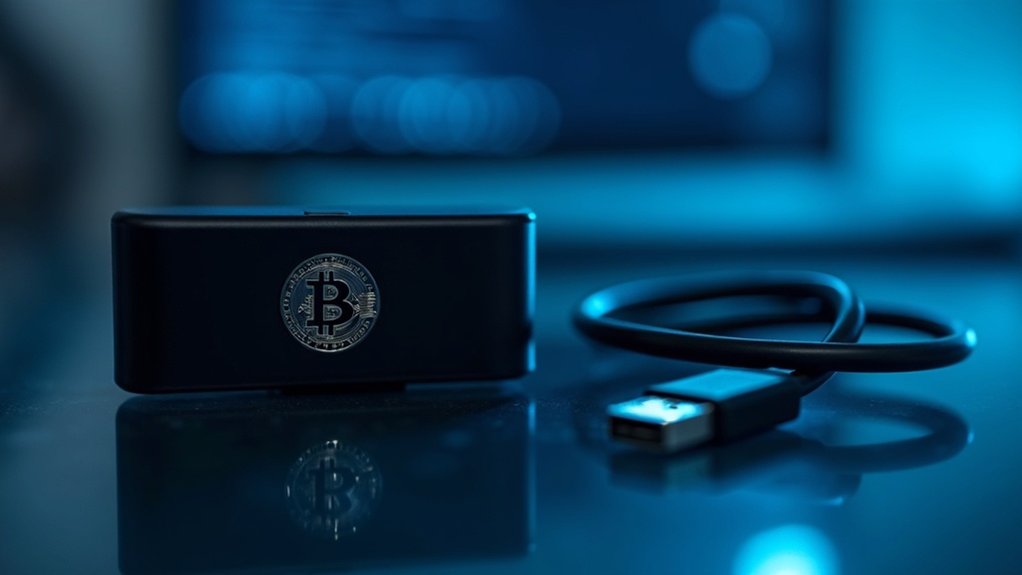Crypto debit cards bridge digital currency with daily spending. They work like regular cards but link to crypto accounts, converting digital assets to fiat currency in real-time. Merchants get paid in local currency, no crypto knowledge needed. These cards offer security features like two-factor authentication and instant freezing if lost. Many provide perks—cashback, staking interest, even airport lounge access. Usable anywhere accepting Visa or Mastercard. The future of money is already in wallets worldwide.
The bridge between digital currencies and everyday spending has arrived. Crypto debit cards look just like regular plastic but pack a revolutionary punch. These payment tools let crypto holders spend their digital assets at ordinary merchants – no crypto knowledge required on the seller’s end. They function identically to traditional debit cards but connect to cryptocurrency accounts instead of bank accounts. Simple concept, game-changing implications.
How do they work? Magic – well, actually technology. When you tap, swipe, or insert your crypto debit card at a store, the system automatically converts your cryptocurrency into fiat currency right then and there. Real-time conversion. No waiting days for funds to transfer. The merchant gets paid in dollars, euros, or whatever local currency they use while you spend your Bitcoin, Ethereum, or other supported cryptocurrencies. It’s instant. Seamless. Revolutionary. Like SPV nodes in blockchain networks, these cards prioritize efficiency and accessibility while maintaining security through trusted verification systems.
Real-time crypto-to-fiat conversion—the merchant sees dollars, you spend Bitcoin. Magic disguised as technology.
Security matters with these cards. Most providers don’t mess around – they implement two-factor authentication, let you freeze cards instantly if stolen, and offer virtual cards for safer online shopping. Visa reported an impressive 2.5 billion dollars spent on crypto-linked cards in the first quarter of 2022 alone. Some even include biometric protection. Because nobody wants their crypto stolen. Nobody.
These cards aren’t just practical – they’re rewarding. Many issuers offer cashback in cryptocurrency, sometimes up to several percent on purchases. Some let you stake your crypto to earn interest while it sits. Airport lounges, rebates, zero fees – the perks vary by provider but can be substantial. Free money for spending money. Not a bad deal.
The real kicker? Acceptance. These cards work anywhere that takes Visa or Mastercard. Millions of merchants worldwide. Online shops. Gas stations. Grocery stores. Restaurants. Places that would never dream of accepting crypto directly now unknowingly do. The merchant gets their familiar currency; you spend your digital assets. Everybody wins. The crypto debit card completely eliminates the hassle of traditional off-ramping processes that can take days to complete. The future of money is already here – it just happens to look exactly like the plastic already in your wallet.
Frequently Asked Questions
Are Crypto Debit Cards Safe From Hacking or Theft?
Crypto debit cards aren’t completely hack-proof. No way. They’re safer when linked to hardware wallets like Ledger or Trezor that keep private keys offline.
Smart users employ multi-factor authentication, avoid SMS-based 2FA (hello, SIM-swapping), and stay vigilant against phishing attempts.
Public WiFi? Terrible idea for crypto transactions.
Device security matters too—antivirus, VPNs, and updated software are non-negotiable.
The crypto world’s wild west nature means security falls squarely on the user.
Can I Use a Crypto Debit Card in Countries With Crypto Restrictions?
Using crypto cards in restricted countries? Not happening.
Providers typically block service in sanctioned nations like Iran and North Korea.
Even in places with partial restrictions—India, China, Russia—there are major limitations.
Singapore? No local ATM withdrawals allowed. Period.
VPN workarounds? Good luck. That’s a fast track to account closure.
Bottom line: these cards only work where crypto payments are legal.
The regulations aren’t suggestions—they’re hard stops.
No compliance, no service.
What Happens to My Crypto During Market Crashes?
During market crashes, crypto on debit cards loses value – sometimes dramatically. Every purchase triggers a conversion, so cardholders get less fiat than expected.
Some folks freeze spending, hoping prices recover. Others panic-convert to stablecoins. Card issuers might even pause transactions during extreme volatility.
The harsh reality? That $100 balance might suddenly buy $70 worth of groceries. Market crashes turn crypto cards from convenient to unpredictable, real quick.
How Do Tax Authorities View Crypto Debit Card Transactions?
Tax authorities view crypto debit card transactions as taxable events, period. Each swipe converts your digital coins to fiat—triggering capital gains tax obligations.
The IRS and similar agencies consider this a “disposition of property.” Not complicated, really. They want their cut.
Starting 2025, major exchanges must report your crypto sales on 1099-DA forms. By 2026, they’ll include cost basis too.
Transfer between your own wallets? That’s fine. But spend crypto? Taxman comes knocking.
Can I Load Multiple Cryptocurrency Types Onto One Card?
Yes, many crypto debit cards support multiple cryptocurrencies on a single card.
Cards from Floki, Binance, Nexo, and Mercuryo let users load various crypto assets simultaneously. Floki’s card supports BTC, ETH, USDT, USDC, and FLOKI across eight blockchains.
Pretty convenient, right? Binance converts crypto to fiat at transaction time. Mercuryo tops the list with over 40 supported cryptocurrencies.
Most cards offer apps where users can select which crypto to use first. Geographic restrictions apply, though.









